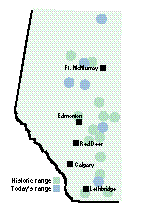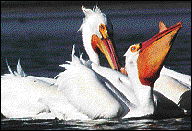 The
White Pelican
The
White Pelican
[elecanus erythrorhynchos]
 The
White Pelican
The
White Pelican[elecanus erythrorhynchos]
Status: Although it was removed from the national list of threatened species in 1987, the American white pelican is still considered endangered in Alberta. The population here is increasing (from 548 nesting pairs in 1980 to over 1,000 today) but fewer than half of the 20 known historic nesting islands are still in use.
Habitat: White pelicans arrive in Alberta in late April. The birds are very social and group their nests together in colonies. They leave before freeze-up in late September and migrate to the coasts of Florida and Mexico for the winter.

Appearance: One of the world's largest birds, it weighs 5-8 kg and has a wingspan up to 3 m. Beneath it's long, flattened bill is a bright yellow-orange pouch for feeding.
Food: Adults can consume up to 2 kg of food each day. In shallow water, they scoop up as much as 20 litres, straining out the young, warm-water fish, salamanders, frogs and aquatic invertebrates.
Breeding: Both sexes prominently display their bright orange bills during courtship rituals which include bowing, strutting and short flights. Egg-laying in a colony begins in mid-May. Both adults tend the large, chalky white eggs until they hatch about a month later.
Lifespan: 12-14 years in the wild.
Risk factors: The most significant effect on white pelican populations in Alberta is disturbance of their breeding sites, by humans or industrial activity. The birds may abandon an entire nesting colony, leaving eggs and young chicks to be trampled or exposed to harsh weather and predators.
Changing water levels due to drought, irrigation and recreational use may also cause the birds to abandon a colony, at least temporarily.

Management and Outlook: Since 1977, seven breeding areas have been designated seasonal wildlife sanctuaries in the Wildlife Act. It is illegal to enter or approach within 800 metres of these sites between April 15 and Sept. 15.
Where lake levels have made nesting islands unsuitable for pelicans, new ones have been built in some lakes in Alberta.
It is illegal to kill white pelicans or to disturb their eggs or nests at any time in Alberta.
Photo: G.W. Beyersbergen
Want to help? Join or Make a Donation to an Organization that makes a difference.
If you live in the united states, these green links will take you to organizations that make a difference there.